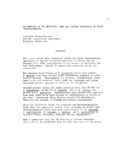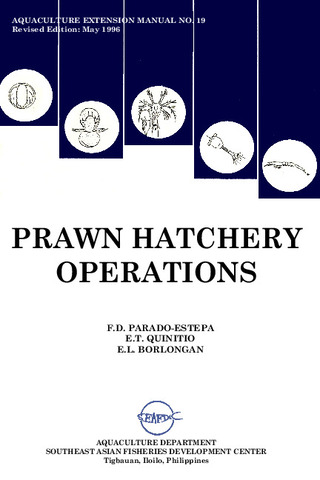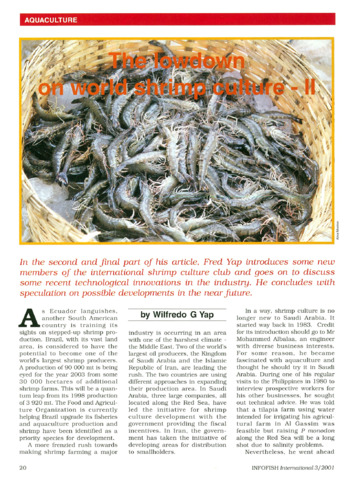Studies on the sources of luminescent Vibrio harveyi in Penaeus monodon hatcheries
- Global styles
- MLA
- Vancouver
- Elsevier - Harvard
- APA
- Help

View/
Date
1992Page views
6,453ASFA keyword
AGROVOC keyword
Taxonomic term
Metadata
Show full item record
Share
Abstract
One of the major problems in the otherwise highly successful Penaeus monodon hatchery industry in the Philippines is the occurrence of luminescent bacterial disease due to Vibrio harveyi. The possible sources of the bacteria were investigated. Eggs within the ovaries of stage III and IV wild-caught and ablated female P. monodon harbour no bacteria. On the other hand, the midgut contents of these spawners, as well as of pond-reared juveniles, contained numerous luminescent bacteria. Plate counts of the exoskeleton from all sampled females revealed that V. harveyi is a minor component of the exoskeleton-associated flora. Scanning electron microscopy of the exoskeleton showed no significant attached populations. The bacterial loads of Chaetoceros calcitrans, a marine diatom, and Artemia salina nauplii were likewise estimated. C. calcitrans did not harbour V. harveyi at any phase of its growth. Twenty-four-hour-old A. salina appeared to have no resident V. harveyi, but its culture water contained small populations of these bacteria. These data show that the main source of the luminescent bacteria is the midgut contents of the mother, which are shed into the water almost simultaneously with the eggs during spawning.
Type
Conference paperCollections
- Conference Proceedings [299]
Related items
Showing items related by title, author, creator and subject.
-
An overview of the nutrition, feed and feeding techniques of prawn penaeid/shrimps
Piedad-Pascual, Felicitas (Philippine Council for Aquatic and Marine Research and Development, 1989)This paper echoes what transpired during the first International Conference of Penaeid Prawns/Shrimps held in Iloilo City in December 4-7, 1984, particularly on the Nutrition nd Feed Development. Around 25 papers were ... -
Series: Aquaculture extension manual; No. 19
Prawn hatchery operations
Parado-Estepa, Fe D.; Quinitio, Emilia T. ; Borlongan, Emeterio L. (Aquaculture Department, Southeast Asian Fisheries Development Center, 1996-05)
The manual, an updated version of the 1984 SEAFDEC/AQD manual, presents the underlying principles and step-by-step instructions of prawn larval and post-larval rearing. The techniques described are not only applicable to ...
; Borlongan, Emeterio L. (Aquaculture Department, Southeast Asian Fisheries Development Center, 1996-05)
The manual, an updated version of the 1984 SEAFDEC/AQD manual, presents the underlying principles and step-by-step instructions of prawn larval and post-larval rearing. The techniques described are not only applicable to ... -
The lowdown on world shrimp culture - II
Yap, Wilfredo G. (INFOFISH, 2001)This paper introduces some new members of the international shrimp culture club and goes on to discuss some recent technological innovations in the industry, particularly the polyculture of tilapia (mainly Oreochromis ...





